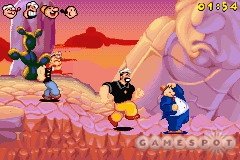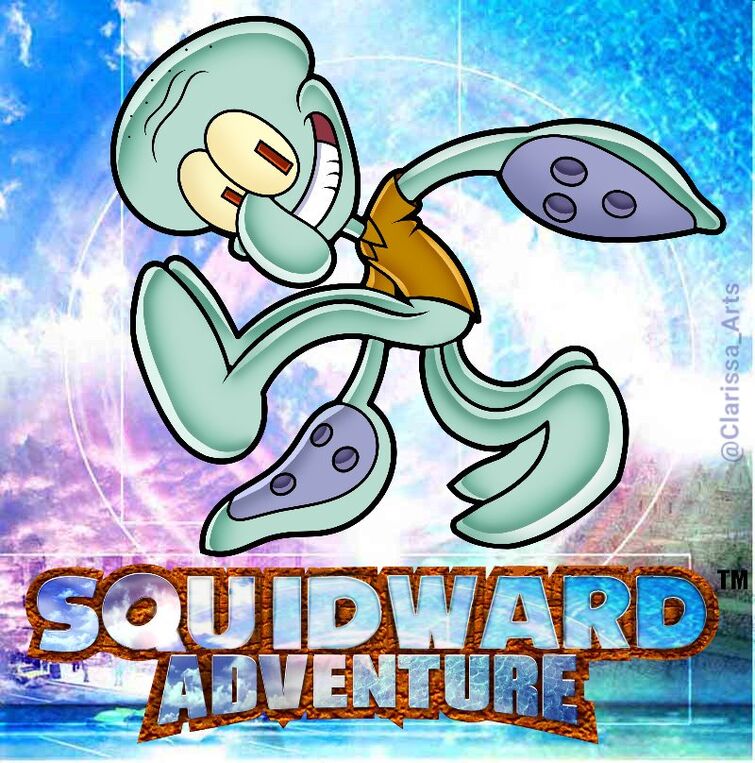Ok I know we already have two Sonic equivalents but dang it, what's one more
The Talented Mr. Tinker
In the early 90's, SEGA was looking for a new mascot to replace Alex Kidd. Blah blah blah, design contest, you know the story. However, a certain blue hedgehog was turned down, because Sega wanted to try to be less teen-and-young-adult oriented, and more approachable by players of all ages. That's when Tom Kalinske and Yuji Naka, at opposite ends of the planet at that time, agreed on a concept by Naoto Oshima of a bumbling, sleepy inventor. Inspired by former US President Theodore Roosevelt, Eggman (soon renamed to "Mr. Tinker" to seem more friendly) bore silly glasses, a large mustache, and goofy pajamas. He is a very tired guy, as he spends all day inventing for his village - making toys, repairing watches, even scultping new buildings, all without asking for a single thing in return.
The Talented Mr. Tinker for the SEGA Mega Drive was a light-gun shooter, but what set Mr. Tinker apart form the rest of the crowd was that you weren't defending yourself, but rather, the title character. Mr. Tinker would go to bed, and then the level starts out in his dreams, or at least they seem that way at first. You shoot various bogeymen and generic fears (spiders, etc) from the easily frightened Mr. Tinker. Once you got to the end of the level, Mr. Needlemouse (a concept for the game's original protagonist) would appear, solidifying this dream as a nightmare. He had a spiky, robotic, gunmetal blue appearance, and it was later revealed that he was an accidentally powerful robot created by Mr. Tinker who soon gained sentience and became evil. Needlemouse's main motivation is that he wants as much room to run around as he can, and if that means getting rid of nature to provide racetracks, then so be it. In these boss sections, Tinker makes a break for it, and while he is faster than Needelmouse, the latter has access to slopes that increase his momentum, which means the player must slow him down by shooting parts of the enviornment to create obstacles behind Tinker and in front of Needlemouse. If you fail to do so, and Needlemouse catches Tinker, the blue robot will be able to enter the "real world" (in-game) and set his plans there, resulting in a surprisingly dark Game Over screen. The "Tinker spends the day inventing, goes to sleep, walks around dream, runs away from Needlemouse" thing continues on until the game's climax, where Mr. Needlemouse transforms into a terrifying, giganctic version of himself, attacking Tinker from the background in a desolate nightmare world. You have to directly attack Needlemouse this time, as he has become less robotic and more organic in this nightmare, therefore allowing light gun shots to hit him rather than bouncing off like they would have in other levels. When completed, Mr. Tinker wakes up relieved, and the first thing he does is go buy a dreamcatcher from the local village shop.
The game was recieved well from critics universally, all hailing the game's slow and methodical pace, which they found a refreshing change of pace from the speed demons of the day like Winstann. Speaking of speed demons, Mr. Needlemouse often got even more love in the fan community of Mr. Tinker, and early Internet discussions wondered what it would've been like if the protagonist and antagonist had been swapped before development. Mr. Tinker would continue to receive games in this Mega Drive era, seeing him teaming up with an ancient keeper of dreams (this universe's Knuckles) and inventing his own twin robot lackeys to take on Needlemouse, Orbot and Cubot. Mr. Needlemouse would even see his own spinoff series on handheld devices, which took inspiration from his momentum-based chase sequences in the Tinker games, in order to capitalize on payers who
did want a faster experience. These games, though, didn't get as much praise as Tinker's.
 AlRex
Felix the Cat (1919)
AlRex
Felix the Cat (1919) Wario Wario Wario
Lady Bow (1984)
Wario Wario Wario
Lady Bow (1984) Champion of Hyrule
Winstann the Gnome (1978)
Champion of Hyrule
Winstann the Gnome (1978) Qwerty UIOP
S.A.M. (1981)
Qwerty UIOP
S.A.M. (1981) DragonRobotKing26
Control Tbe Robot (1982)
DragonRobotKing26
Control Tbe Robot (1982) cashregister9
Alex Ape (1987)
cashregister9
Alex Ape (1987) 




